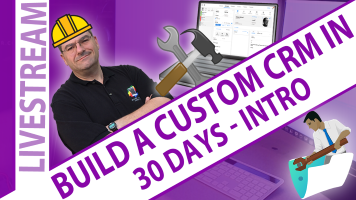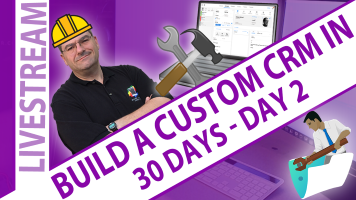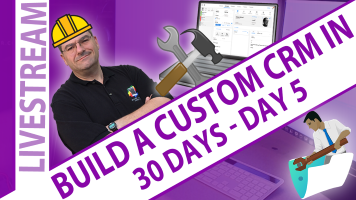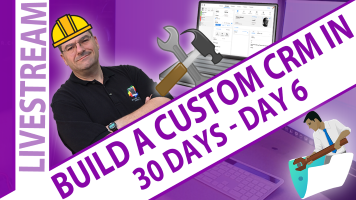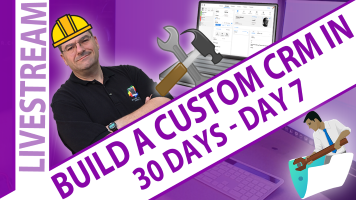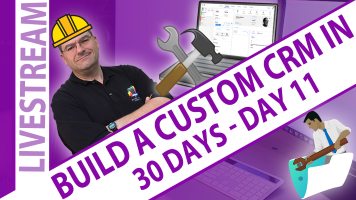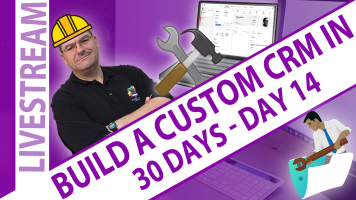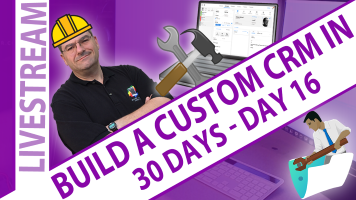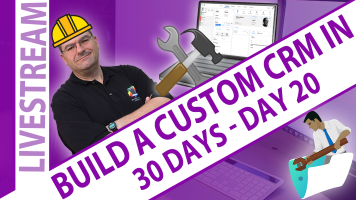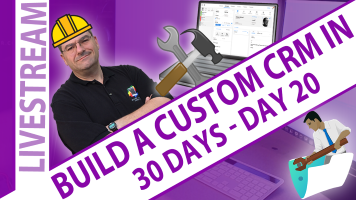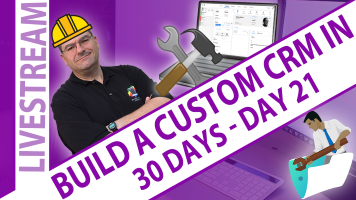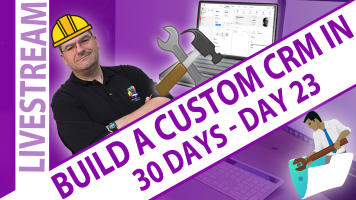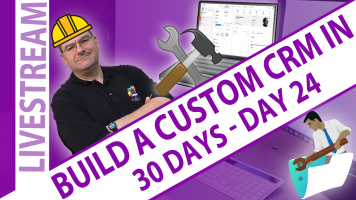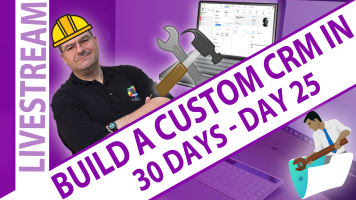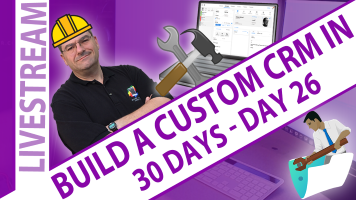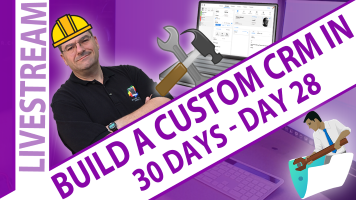Welcome!
This website is designed specifically for the Custom CRM in 30 Days FREE daily live training course. The course is intended for true new Claris FileMaker users that want to create a custom app using the FileMaker Platform. This training will focus on the new FREE and unlocked CRM for the FileMaker Platform. This training will start on basic topics and progress over the length of the course to more intermediate topics.
Day 1: Introduction to course
Claris FileMaker Platform Overview The Claris FileMaker Platform Combines different components into a cohesive package: Data,Interface, App Logic. Also covered terminology, Servers, Clients. This series will demonstrate the features of FileMaker and how you can make a CRM. We discuss FMSP (FileMaker Starting Point) as a free and fully customizable CRM for your solution. We talk about how you can host your app on Claris FileMaker Server or Claris Cloud. Server is for an on-premise solution within your physical office space. Cloud is more for remote solutions. We talk about mobile options, via Claris Filemaker Go, which allows users to access FM apps on iPhone. Native Android compatibility is unlikely but is accessible with Livecode. We broach the topic of Claris Studio as a future product. It is currently focused on creating a public facing webform for collection of data. We have a walkthrough about uploading and accessing your file through FileMaker Server.
Day 2: The Basics
User Basics. Navigating Layouts. Navigating records. Layout Mode, Browse Mode, performing finds & sorts. Form Views, List Views and Table Views. Status toolbars in browse mode or Find Mode.
Day 3: Security Basics and Server
Basic of Security. Internal Accounts, privileges Sets, Roles, Extended Privileges. How to upload a database file to a FileMaker Server. FMS vs. Cloud. Building a launcher file for user distribution.
Day 4: Introduction to Layout Objects & Recycling Previously Built Solutions
Introduction to Layout Objects, and Layout Panes. How to recycle starter solutions, what starter solutions are available, and give an explanation of UI/UX.
Day 5: Introduction to Scripts
Scripting Basics. Script workspace, disabling/enabling code, understanding context. How script may fail without proper context. A button can perform a single script step, or can trigger an entire script. Conversation about Merge Fields. Conversation about Plugins. Doing searches on date fields. If Then Script Steps as opposed to If Function and Case functions. Performance Conversation: Beginner Developers, Intermediate Developers, Advanced Developers
Day 6: Local and Global Variables
Storing values to transfer between scripts, and between processes is easy to do. We use to use Global fields for this. But Variables are easier to manage and handle, and they are cleaner to use.
Day 7: Introduction to Relationships
The relationship graph in FileMaker is similar to ERD, but different. Basic of connecting two tables together. The construction of keys. Seeing data through the relationship. How to identify entities, or elements of your business
Day 8: Organizing the Relationship Graph
Review how developer organize the graph. Anchor Buoy is a clean and simple technique, that makes it easy to understand the graph, and also provides for high performance.
Day 9: Many to Many relationships
Many to Many relationships are hard to understand in an educational environment. Whatever you break it down to business issues, that these are very easy to understand. Developers tend to use the word join table, when they‘re unable to describe the actual underlying business process.
Day 10: Calculations, Functions, and Operators
Understanding how calculations work. We will discuss Operators, and Functions. We also spend some time creating Date based calculations, which most developers find useful. We use the Data Viewer to test calculations.
Day 11: Most Common Script Uses
On day 10, we talk about the most common scripts that most beginner FileMaker developers will want to write, specifically about sorts and found sets.
Day 12: Document Management
Today we discuss the basics of containers and document management. What is the difference between standard and interactive containers. We will learn about storage options, security, validation, and optimization. We will also go over how to capture signatures, resize images within a container, and capture thumbnails. We will also go over techniques on importing, exporting, capturing signatures in Go, resizing images, and capturing thumbnails.
Day 13: Navigation & Device Screen Sizes
Design Considerations for Phones, Tablets, and desktop computers. Mouse or Touch, regulates the size of the on-screen objects. Also discussing layout objects that can help manage screen real estate, Slide Control Tab Control, and Pop over Windows.
Day 14: Print Layouts, Scripting Printing or Export PDF
Printing to paper or PDF takes a bit for fore thought. Think about having Print specific layouts, that are different than data entry. Printing a PDF is essentially the same as printing, but you will probably want to write a script that saves the PDF to a specific location on your computer.
Day 15: Exporting and Importing in FileMaker
Understand the Import and Export processes. Understand differences between running these manually and via script. Understand how imports can be saved with a script for future re-use. Also learn about auto-enter options as records are imported.
Day 16: Understanding Portals in FileMaker
What is a portal, and what does it really do for you. If you have related fields from another table, you can only see the FIRST related record. If you want to see all the related records, you need a Portal. Portals can have customized sort orders, as well as customized filters.
Day 17: Reports and Subsummaries
Reporting is the last thing that developers typically build in a FileMaker solution. But report should ideally be documented and planned BEFORE building the FileMaker app. Summary fields, and Subsummary body parts are essential for MOST reports.
Day 18: Multi-user vs Single User Files
Understanding how FileMaker behavior changes after being hosted on a server is important. Record locking is an important consideration. Script frequently can lock records, so we’ll explore this issue, along with Error Trapping. We will also look at how Global fields behave differently.
Day 19: Naming Conventions for Layouts/Scripts
Unique, consistent names for scripts, layouts, relationships, and table occurrences are needed to stop developer confusion. Resequencing is inevitable, we discuss how you can make this easier on yourself. There are specific layouts that can’t be renamed without breaking other parts of your database. Anchor-buoy has very specific naming conventions to make it easier to “read”.
Day 20: What Tables do you need in your Database? Conversation about Data Modeling.
In a followup to naming conventions, We discuss what tables you need in your database by breaking open FMSP. You need to understand what exactly you are trying to do to understand what tables you actually need. As an example, we talk about searching across all tables , which is doable, but a real hack. In the process, we convert parts of FMSP into a database for use in the medical field.
Day 21: Calendars
Calendars are not native to the FileMaker platform, and as a general rule are not provided by Claris. Calendars can be rendered using Webviewers, and are a tricky, more advanced topic. We cover the Calendar in FMSP, it’s features, and show you how to move it to a different layout.
Day 22: Emailing
FileMaker Pro has built in script step to send outbound emails. Emails may be sent manually via script step.The Send Mail script step will send text only email through one of two methods. Emails may be sent via a locally installed email application, or emails may be sent out directly to the internet via SMTP (Simple Mail Transfer Protocol) configuration.
Day 23: Script Triggers Day 1 - Startup Scripts and Closing Scripts
By using any of the 26 script triggers in FileMaker, you can run scripts that are triggered by a host of user actions, including layout and record navigation, rotating a mobile device, entering or exiting a field, and changing modes or views. As useful as script triggers are, they can add complexity to your apps, and have the potential for undesirable consequences.
Day 24: Script Triggers Day 2 - Open Q&A
Topics Covered: (1) How to: Reconciling Two Claris FileMaker files, each with it own unique layout changes, and or script changes. Precision XML representation of a FileMaker File (aka Star Trek Transporter) is not been completed by Claris engineering and is a "alpha" feature. It is not ready for "Primetime." (2) Text Replace within a field, Replace Command. (3) Dollar amount in words, in a text field, use a custom function. Brian Dunning custom functions website. (4) Script triggers that activate when the Claris FileMaker app ... is OPENED on a user machine. (5) Script triggers that activate when the Claris FileMaker app ... is CLOSED on a user machine. (6) Properly closing a Claris FileMaker file. (7) Progression of Learning. Intermediate developers typically move calculations to everything in Scripts... to manager performance issues.
Day 25: Script Parameters & Preference Tables
Communicating with a Script that will run, is running, or has already completed is a critical skill. Script parameters are a way of exchanging data to a script that has just been activated. Script results are text strings that come from scripts that have just completed.
Day 26: Conditional Formatting & Invisibility - Thurs
Conditional Formatting allows you to alter the appearance of layout objects based on conditions you specify. We discuss why this might be useful, how to specify multiple conditions, specific formatting for buttons, and how different types of conditional formatting stacks.
Day 27: PO’s - Adding Modules Fri
People often change existing modules in a database into a new one. This time, we copy a estimates module and change it into a PO module, covering everything that needs to be changed and how to change it - layout names, field names, script names, relationships, and more.
Day 28: Scripting - Removing Duplicate Records & Hiding Unneeded Sections - Mon
We cover how to hide objects on your layouts, reasons you might need to hide objects, and understanding the sometimes awkward scripting language in hiding objects. We also break down , step by step, our own deduplication of records script.
Day 29: Open Q&A
We answer a questions from our viewers, talking about how easily a FileMaker file can be corrupted, are there fixes for corrupted databases, and general robustness of the platform. We also answer questions on auto-commit, and if FileMaker has the equivalent of SQL transactions.
Day 30: Layout Inspector
Detailed discussion of the Layout Inspector. FileMaker allows the managing the display of objects on the layout, without affecting the underlying data. Visual styling, object invisibility settings, etc.
Day 31: Basic Cost - Claris Licensing
Claris Licensing can be incredibly daunting to deal with head-on. Richard is here to simplify it for you, and help you make sure you’re getting the best deal. We discuss what Servers you need, concurrent connections, annual licensing, the importance of updates, and more.
Day 32: Charting
The FileMaker platform has built-in charting capabilities. We discuss FileMaker’s charting limitations, available customization, and break down a sample file so you can add charts to your own FileMaker solution.
Day 33: Multi-file Solutions
Most modern FileMaker files will be single file solutions. This is traditionally easier to manage, but there are reasons to have multi-file solutions. Different departments will not want to share the same solution.
Day 34: Beginner’s Questions
We answer another round of questions, including further questions on data separation, table occurrences, global fields, variables, and import and export scripts.
Day 35: Where do we go from here?
The 30-day course is over, but for many developers, their FileMaker learning journey has just begun. With the assistance of two senior engineers, we talk APIs, plug-ins, dynamic value lists, and other complicated topics, as well as where you can go to get more information.
 30 Day CRM
30 Day CRM
